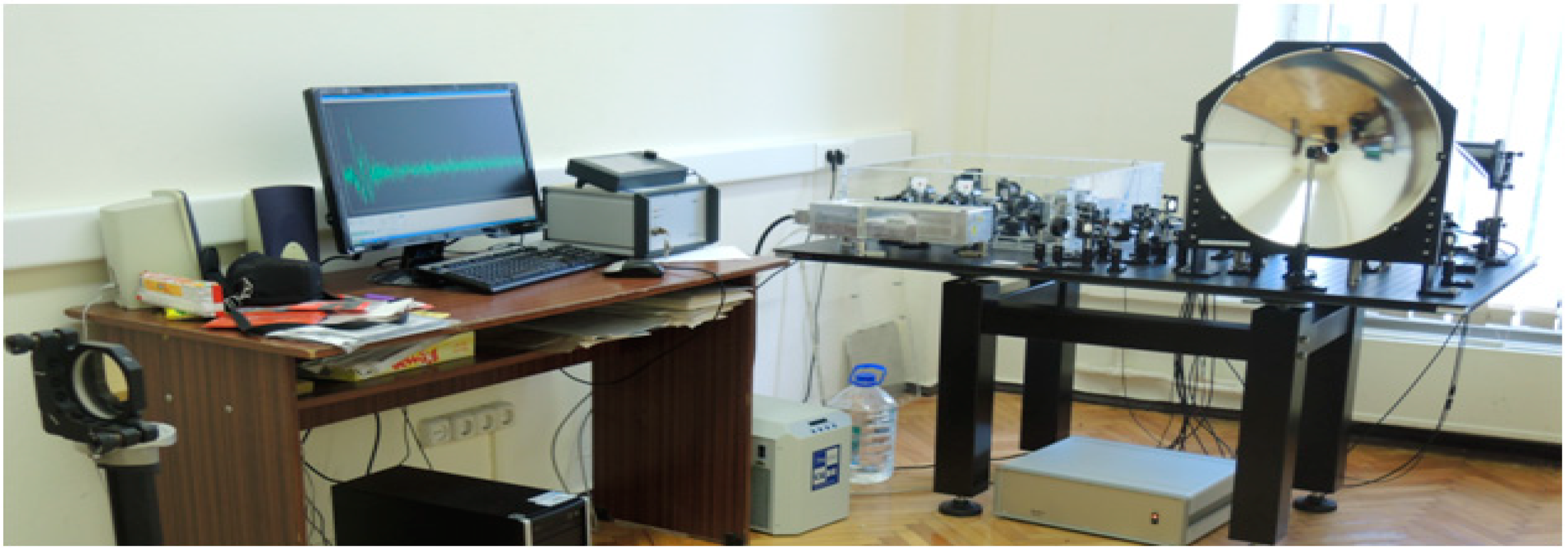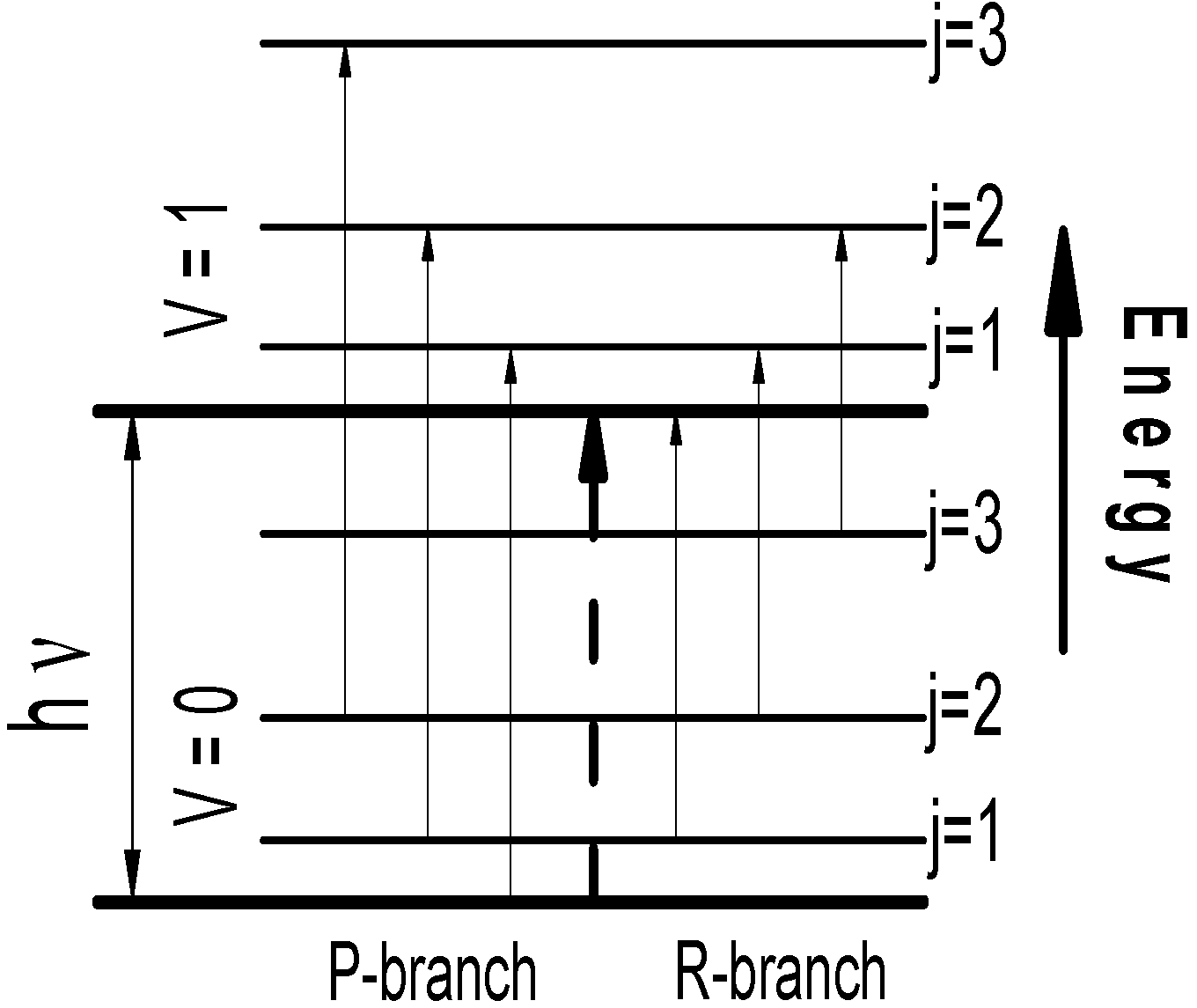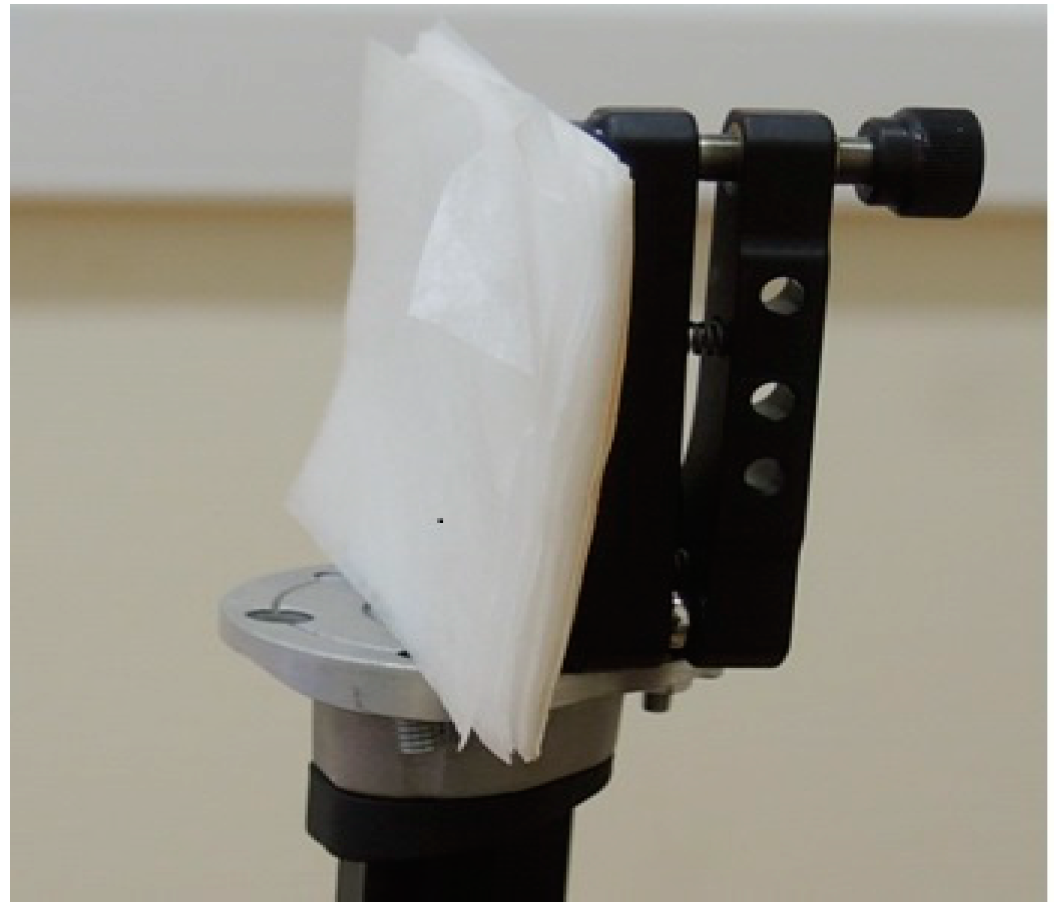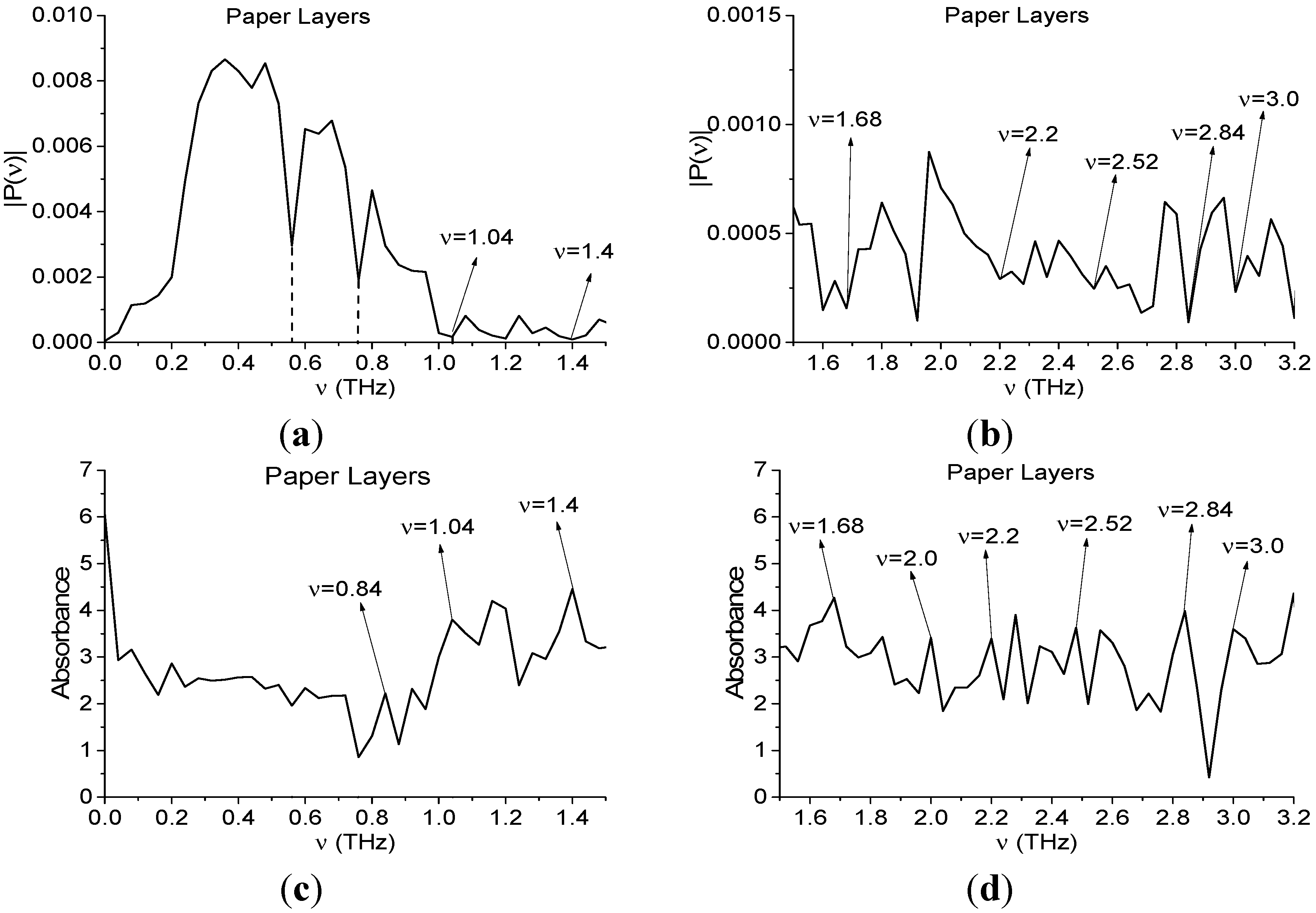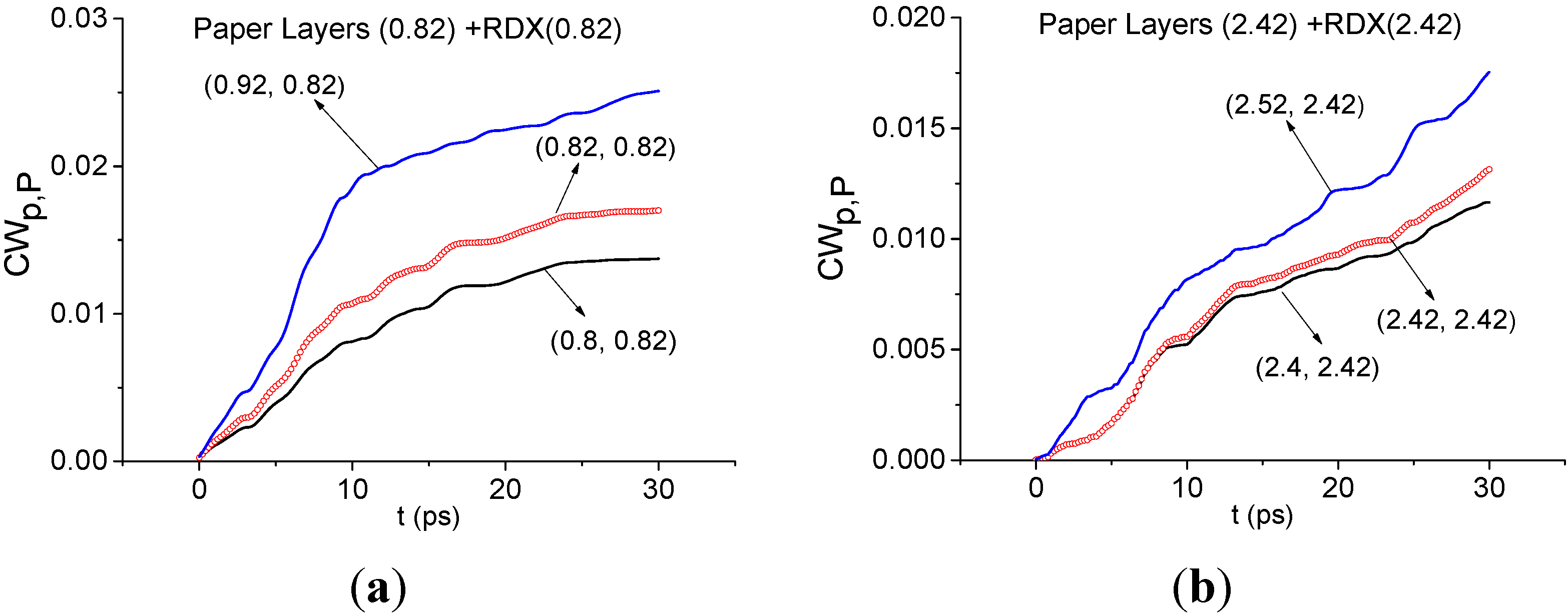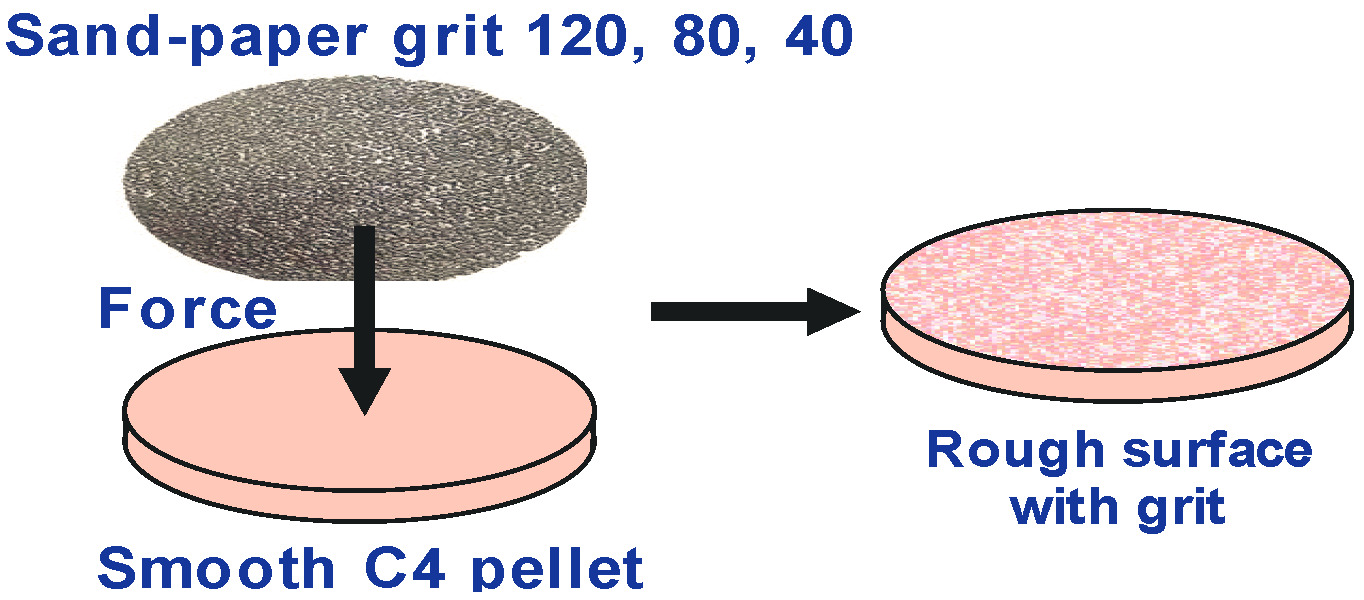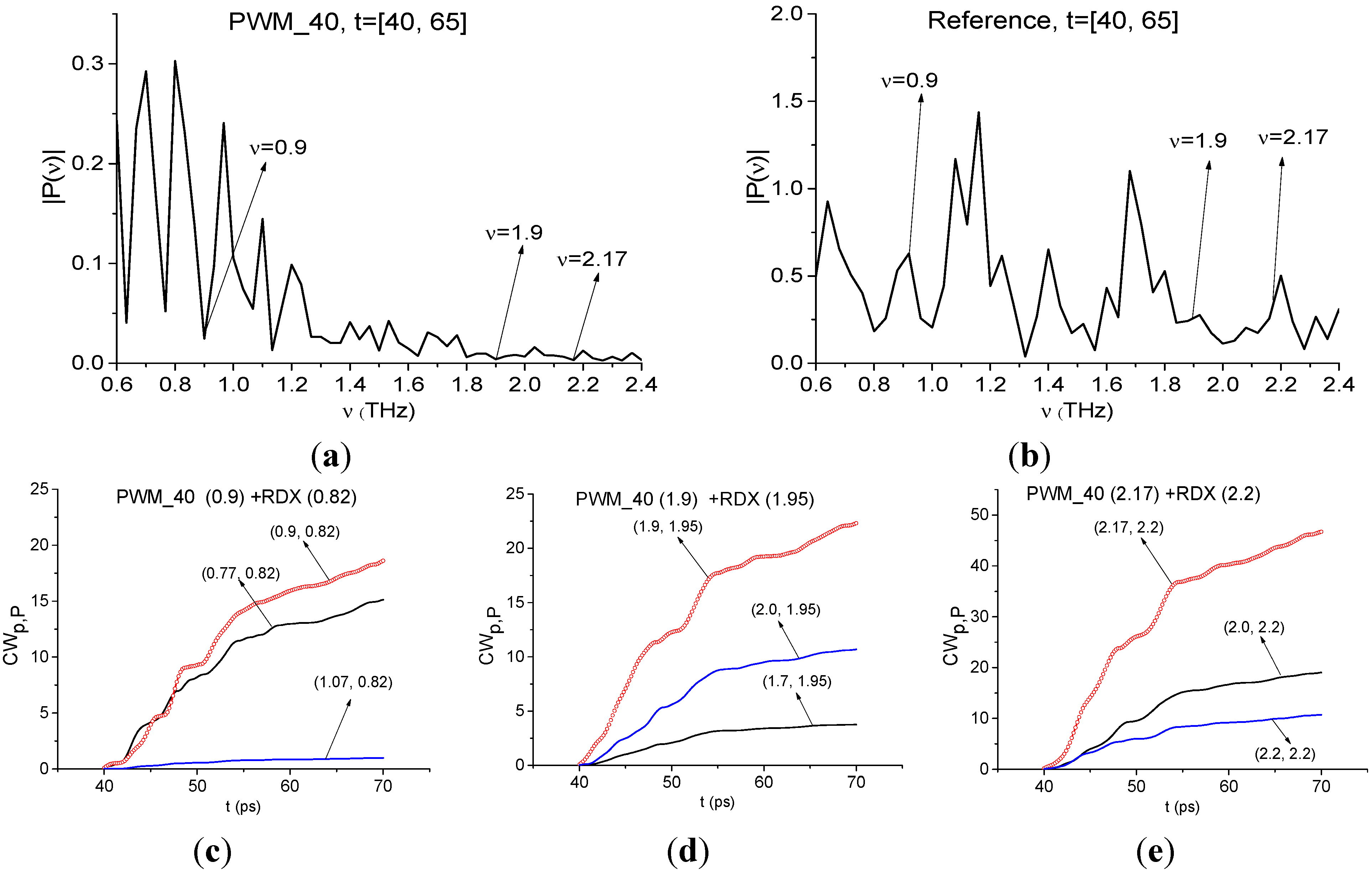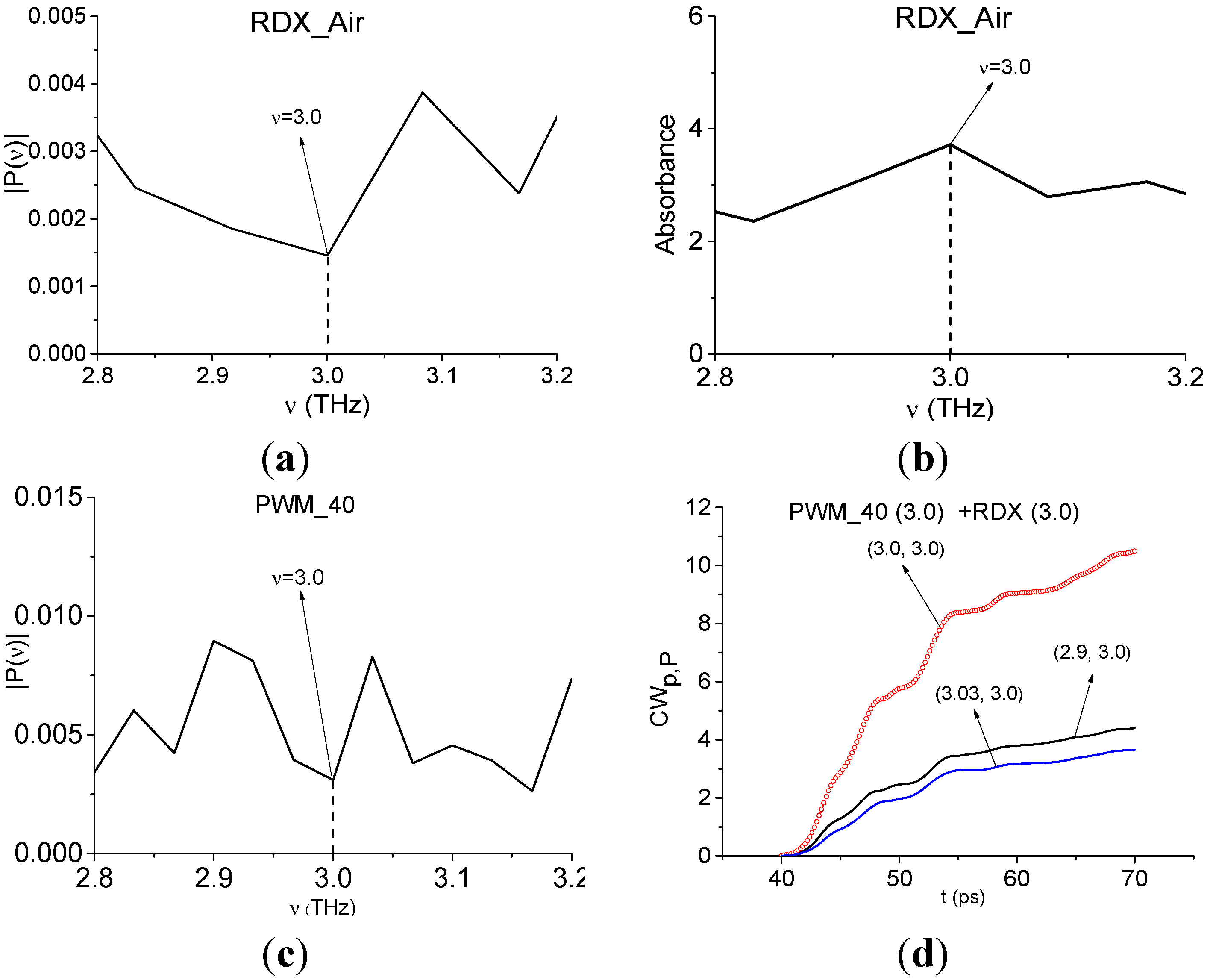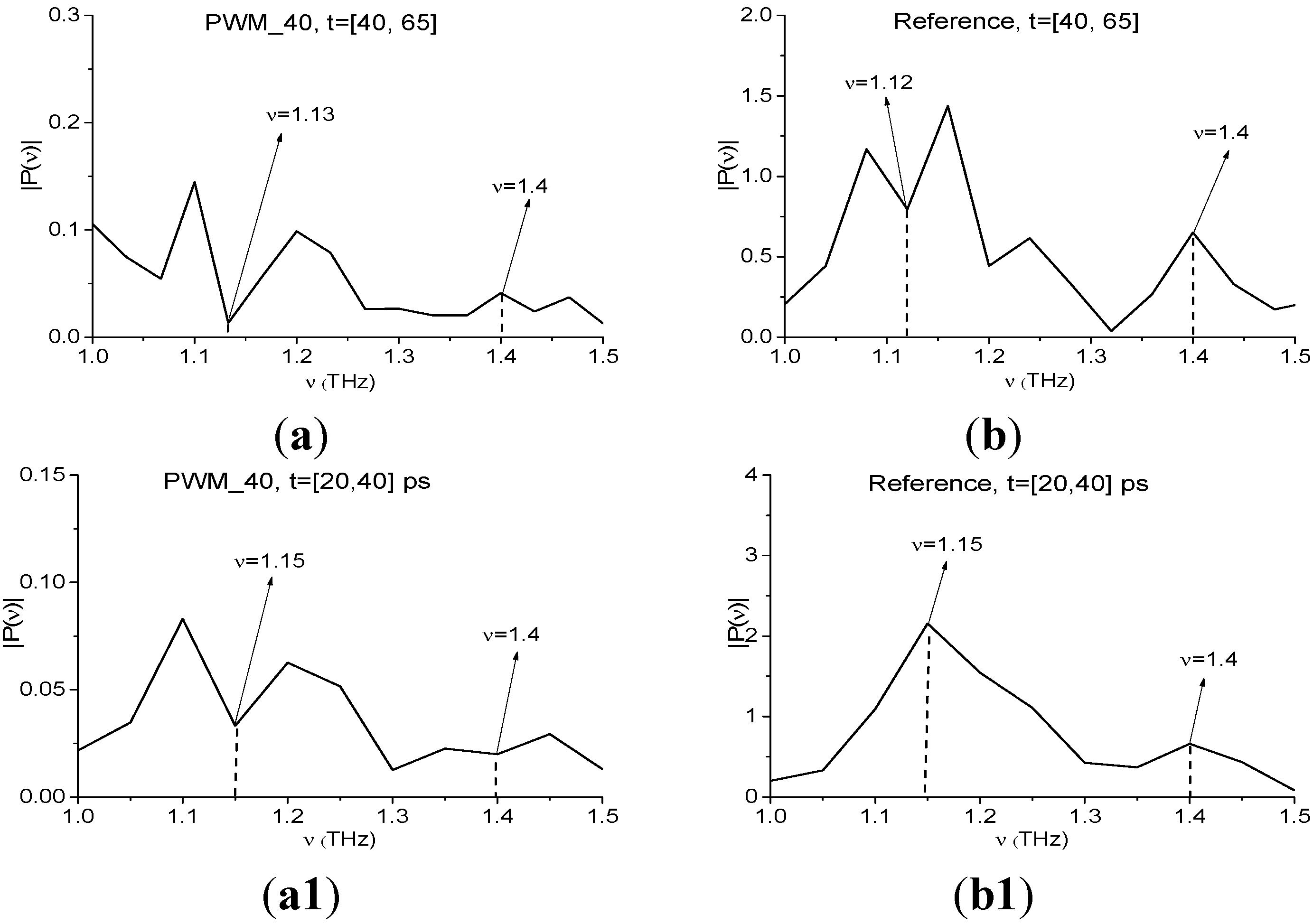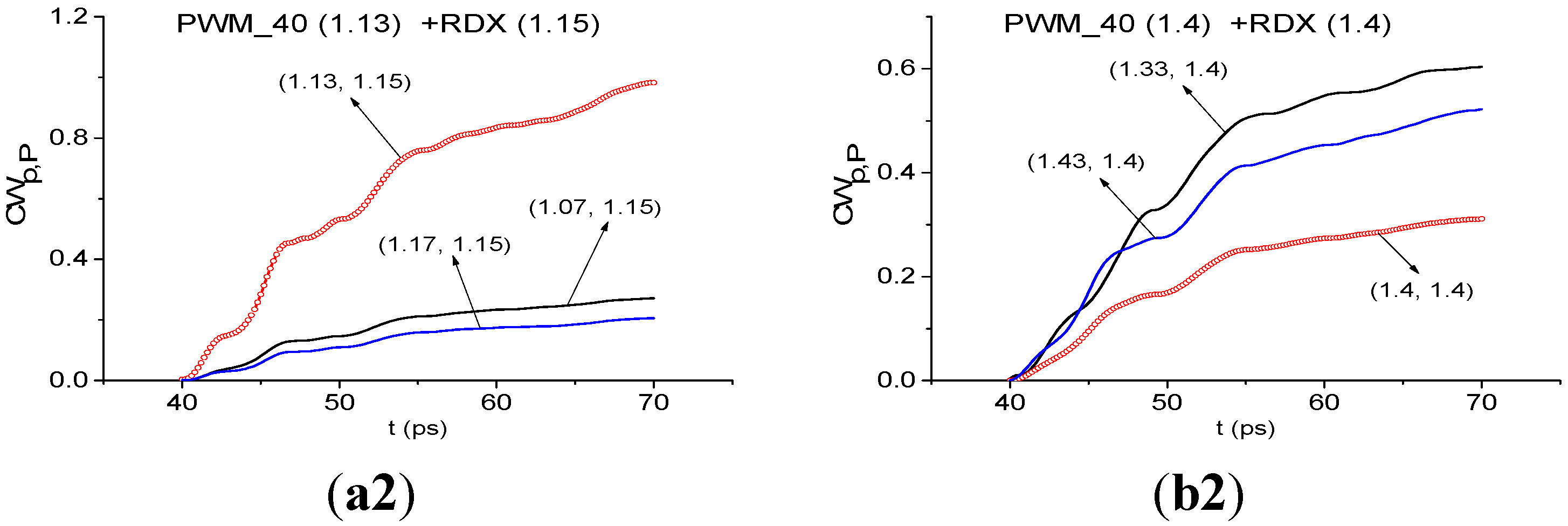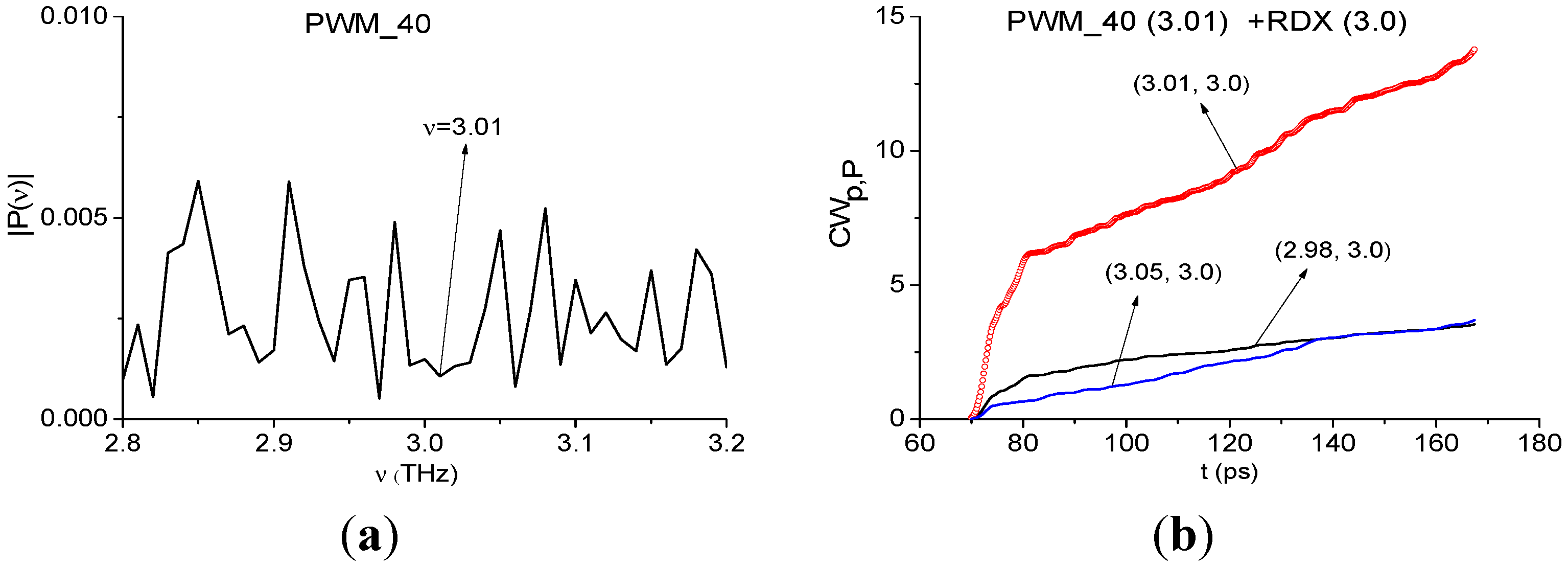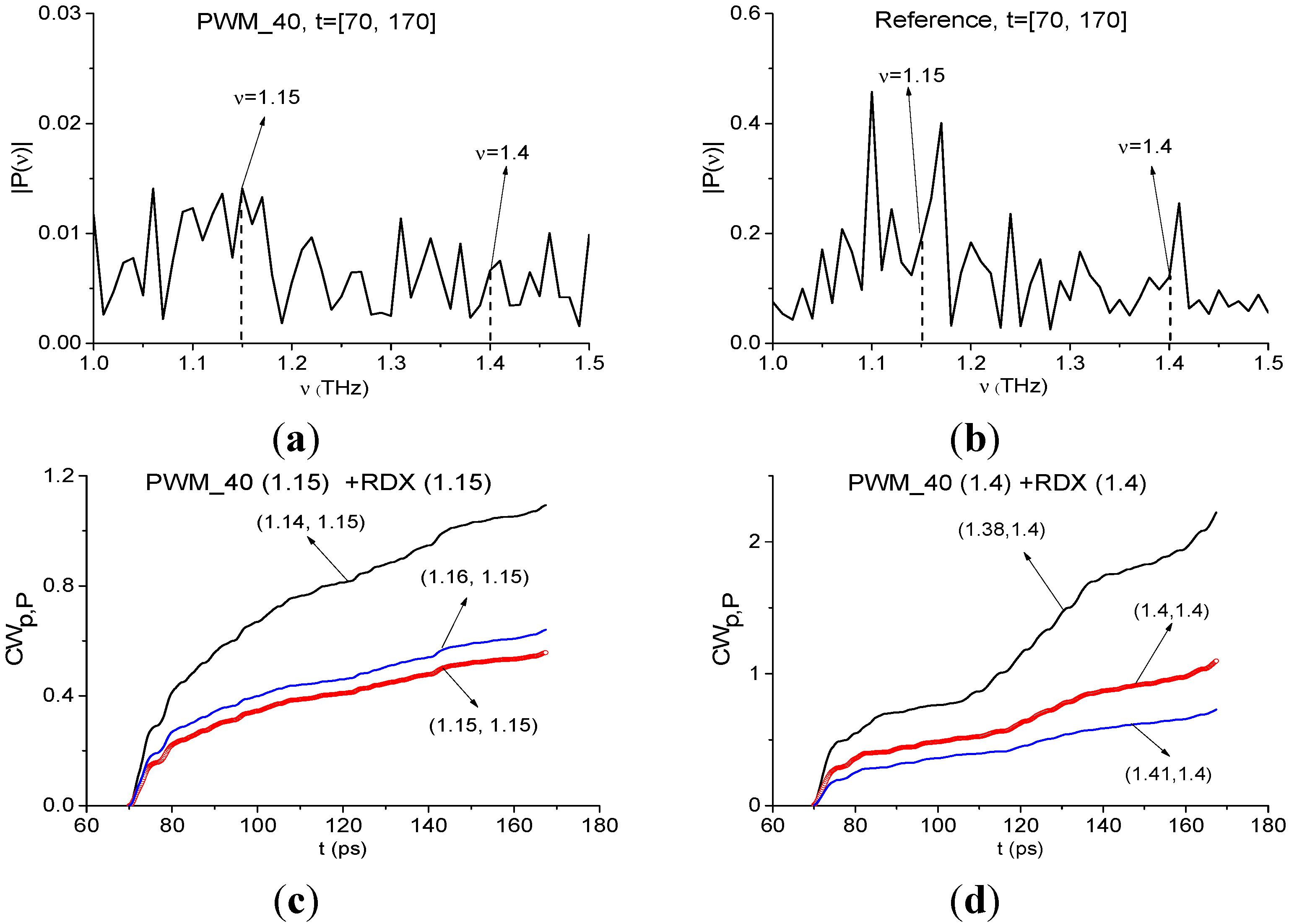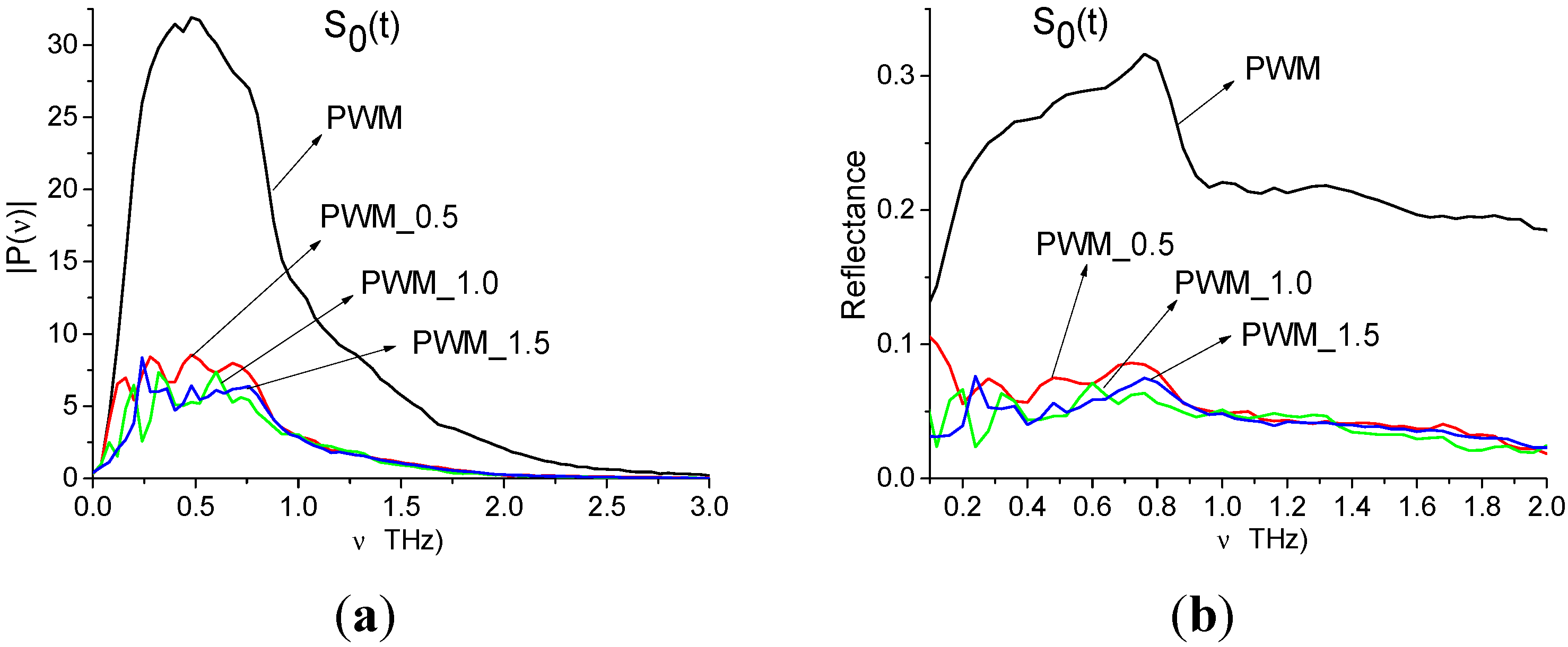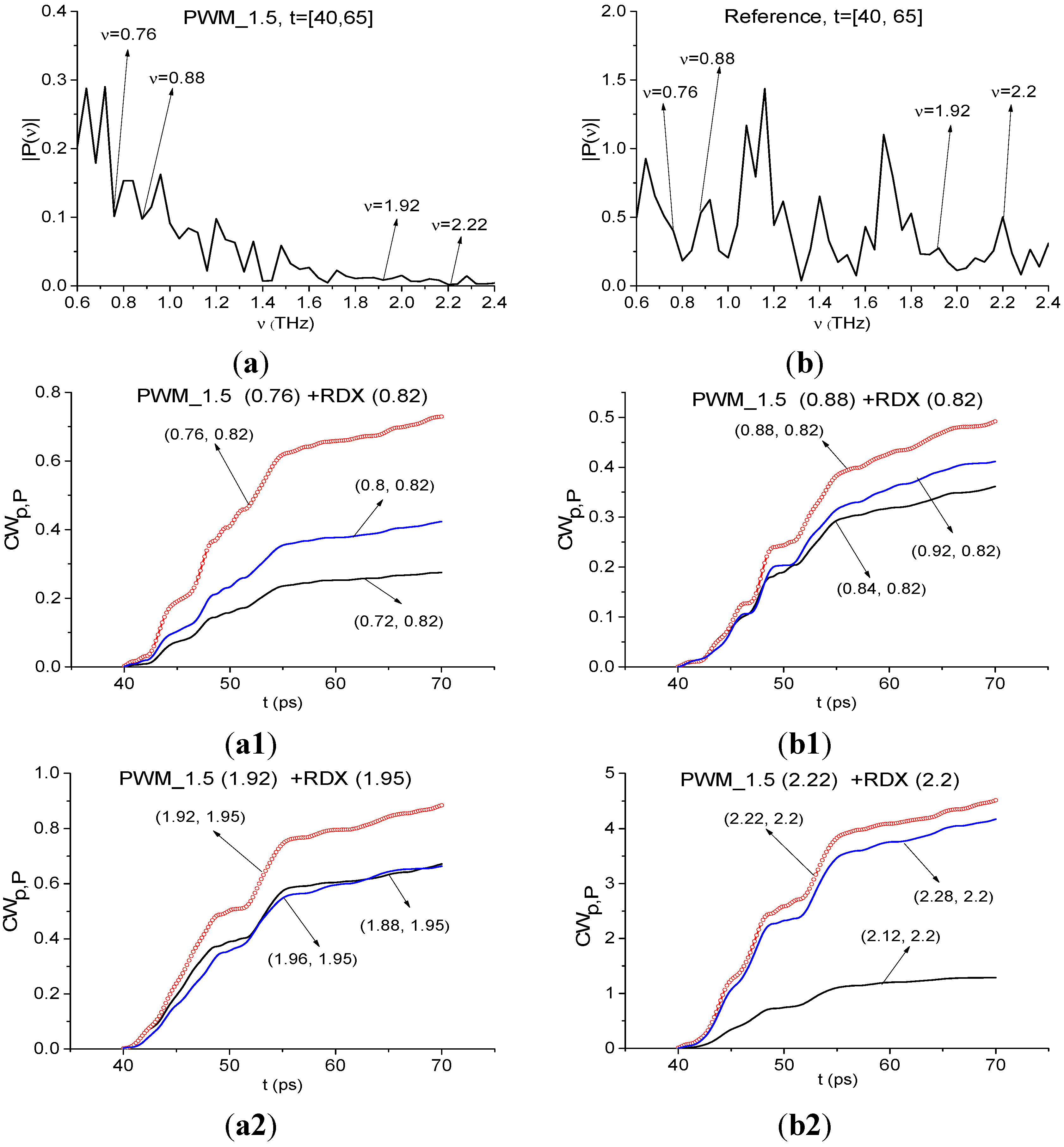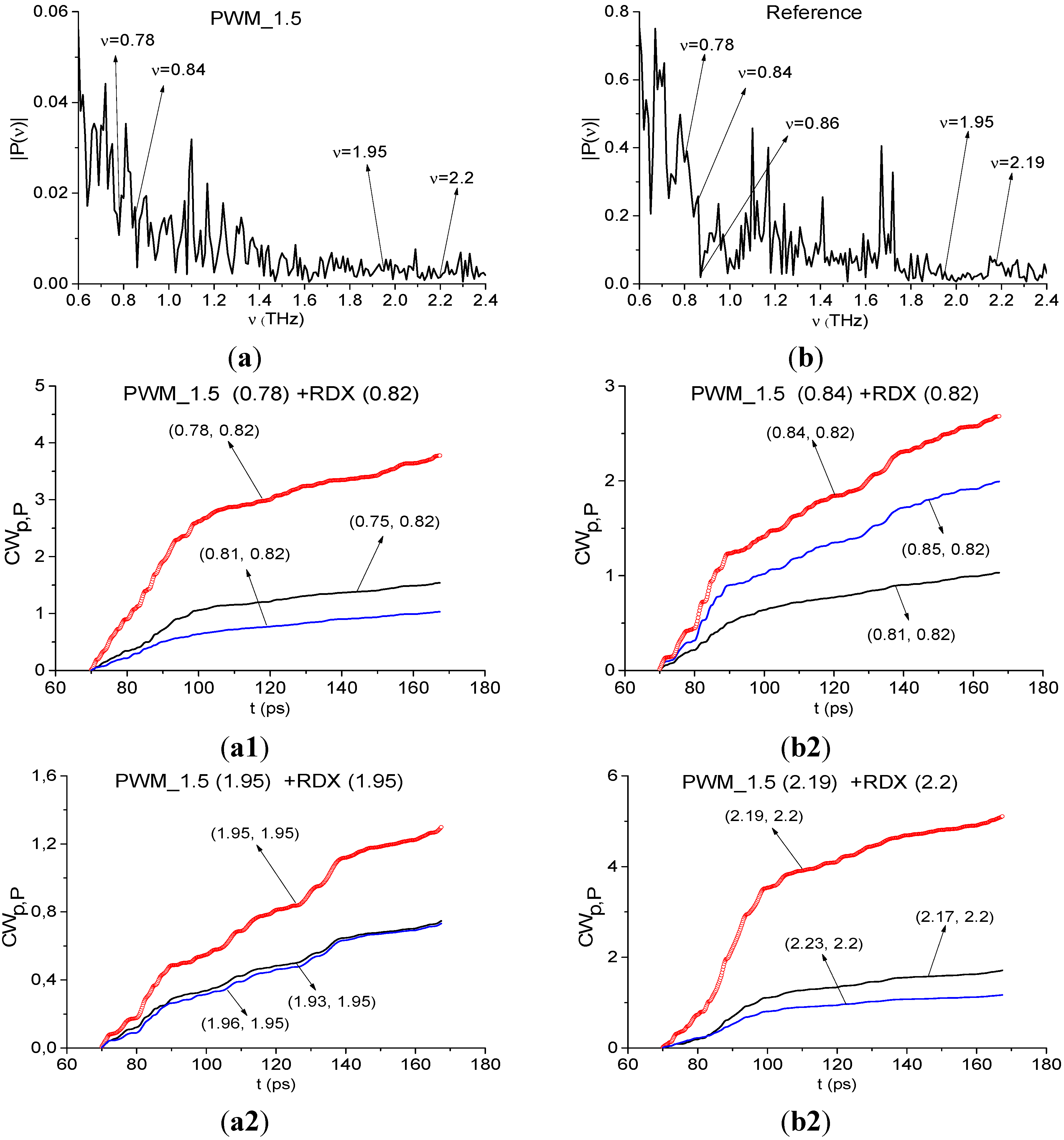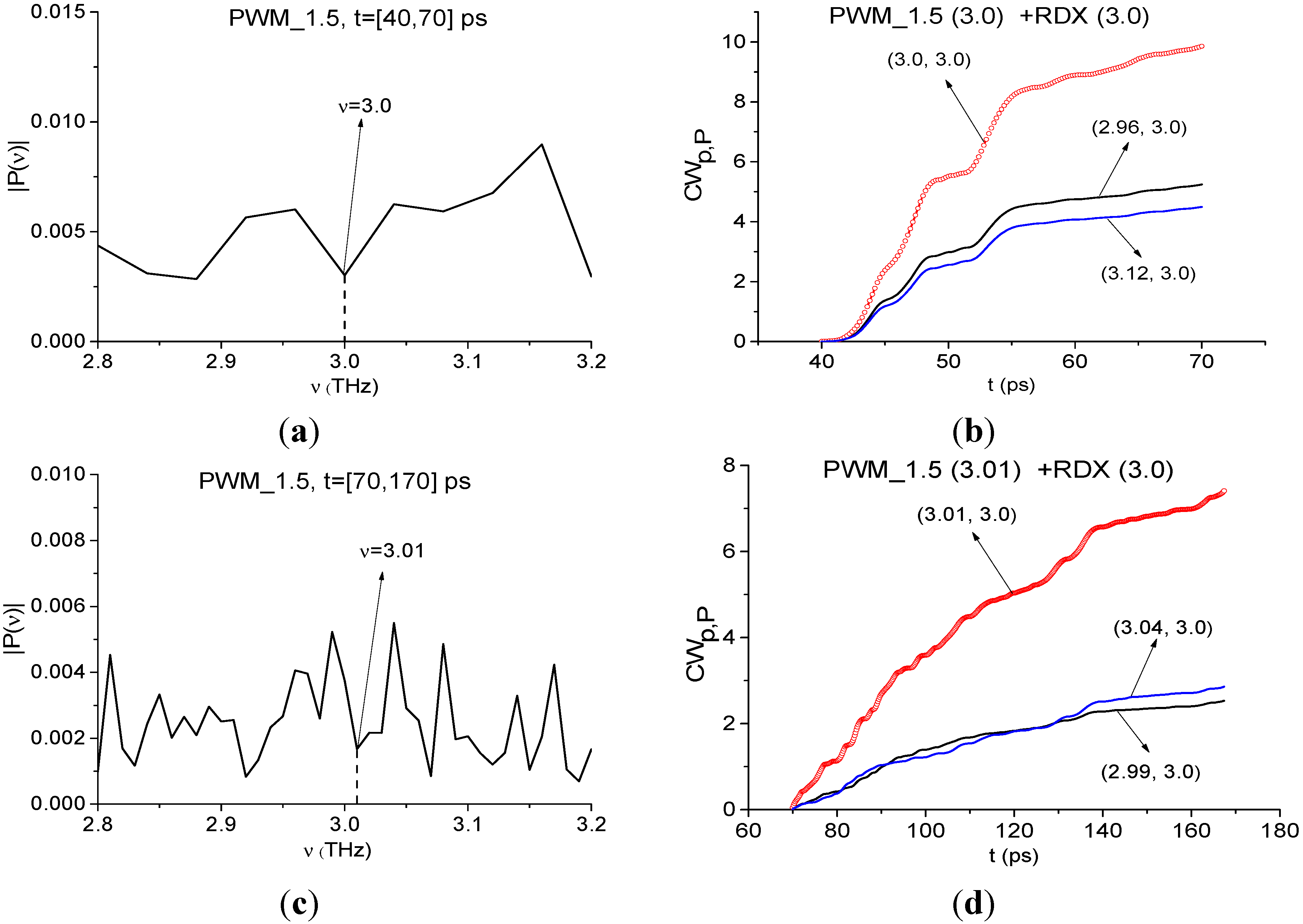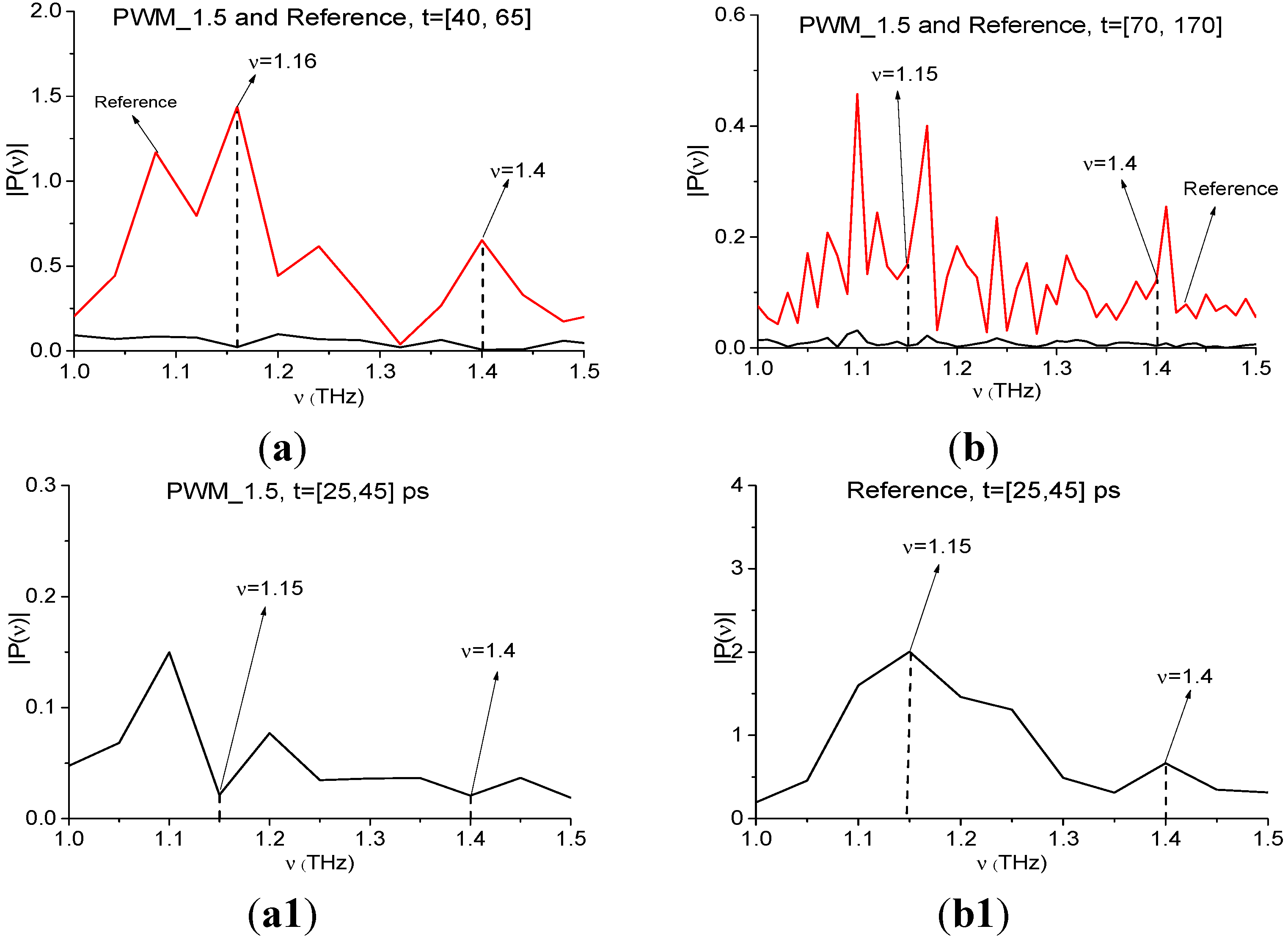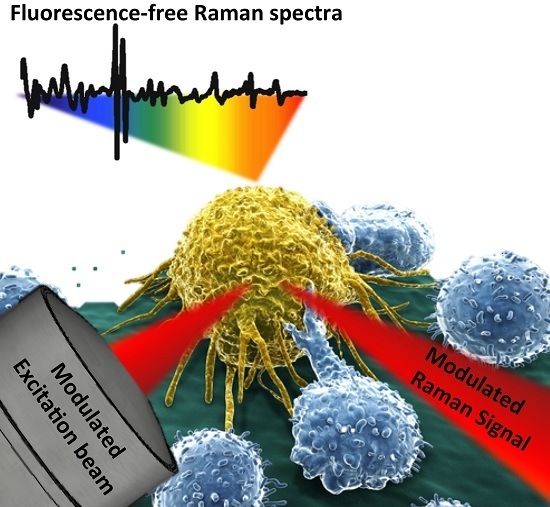In the present section, we apply the modified criteria Equations (5) and (6) for the identification of the explosive PWM C4 in pellets with inhomogeneous surfaces. PWM C4 is a mixture of RDX and plasticizer in the ratio 90%:10%. It is important, that we analyze the signal in the time intervals, which do not contain the main pulse of the reflected THz pulse. The distance between the sample and detector is 30 cm.
4.2.1. Rough Surface
In
Figure 12 we show the PWM_C4 pellet with rough surface treated with 120, 80 and 40 grit sand paper (the root-mean squared height of the grain is 40, 60 and 130 μm, respectively). The weight of all pellets is 600 mg.
Figure 12.
Surface treatment of the PWM C4 tablet [
32].
Figure 12.
Surface treatment of the PWM C4 tablet [
32].
All measured reflected signals (denoted as
SR(
t)), are long-term with duration about 180 ps. We shall call them the PWM_120, PWM_80, PWM_40 signals for rough C4 pellets, correspondingly, and the signal PWM for the initial smooth C4 pellet, see
Figure 13a,b. The signals
SR(
t) are composed from several pulses—the main pulse
S0(
t) reflected from the outer surface of the sample, and the visible sub-pulses
S1(
t),
S2(
t),
S3(
t) due to multiple internal reflection from inner surfaces. Note that we shall consider the averaged signals:
where
T1 = 180 ps is the reflected signal duration. This allows us to eliminate the constant component of the signal and enhance the correlation contrast.
Figure 13.
Reflected THz PWM signal (a) and PWM_40 signal (b) in the long time interval 0 < t < 180 ps.
Figure 13.
Reflected THz PWM signal (a) and PWM_40 signal (b) in the long time interval 0 < t < 180 ps.
In
Figure 14 the Fourier spectrum and reflectance of the main pulse
S0(
t) of reflected signals PWM and PWM_120, PWM_80, PWM_40 are shown. Reflectance
R is calculated as the ratio [
33]:
Here P(ν), PREF(ν) are spectral amplitudes at the frequency ν for the main pulse of the PWM signal and Reference signal, correspondingly. Note that the THs signal, reflected from the gold mirror was used as Reference signal.
We see that both characteristics strongly depend on the explosive shape; the pronounced identifiers of RDX are absent in both the spectra (
Figure 14a) and reflectance (
Figure 14b). Therefore, an inhomogeneous surface distorts the spectral characteristics of the main pulse, which cannot be used for the detection and identification of the plastids. In (
Figure 14c) the Reference signal spectrum is shown. As we can see, there are no minima in (
Figure 14c), corresponding to absorption from environment, during the main pulse.
Figure 14.
Fourier spectra (a) and reflectance (b) of the main pulses S0(t) of the PWM_40, PWM_80, PWM_120 and PWM signals; Fourier spectrum of Reference signal (c).
Figure 14.
Fourier spectra (a) and reflectance (b) of the main pulses S0(t) of the PWM_40, PWM_80, PWM_120 and PWM signals; Fourier spectrum of Reference signal (c).
Below we show the possibility of plastids identification using a short time interval, containing the first sub-pulse
S1(
t) of the reflected THz signal, by means of integral correlation criteria Equations (5) and (6). With this aim, in
Figure 15 the first sub-pulse spectrum for the PWM_40 signal (
Figure 15a) and Reference (
Figure 15b) are shown in the frequency range ν = [0.6, 2.4] THz.
Figure 15.
Fourier spectra of the first sub-pulse for the PWM_40 signal (a) and Reference signal (b) in the frequency range ν = [0.6, 2.4] THz, integral characteristics CWp,P(tn) calculated with the frequencies ν = 0.9 THz (c); 1.9 THz (d); 2.17 THz (e).
Figure 15.
Fourier spectra of the first sub-pulse for the PWM_40 signal (a) and Reference signal (b) in the frequency range ν = [0.6, 2.4] THz, integral characteristics CWp,P(tn) calculated with the frequencies ν = 0.9 THz (c); 1.9 THz (d); 2.17 THz (e).
We see that in
Figure 15a there are minima at frequencies ν = 0.9, 1.9, 2.17 THz, that are close to the well-known absorption frequencies of the transmitted RDX signal ν = 0.82, 1.95, 2.19 THz [
10] correspondingly. The difference between these frequencies may be caused by the frequency resolution Δν = 0.04 THz of our analysis, because of the short time interval
T = 25 ps. In
Figure 15b we see maxima of the Reference signal spectrum at these frequencies, which implies the absence of water vapor absorption. To find RDX in the PWM_40 signal we use the transmitted THz RDX_Air signal (see
Figure 4) as the standard signal and spectral lines dynamics of this signal at frequencies ν = 0.82, 1.95, 2.2 THz. In
Figure 15c,d the integral characteristic
CWp,P(
tn) is depicted detecting the frequencies ν = 0.9 THz (
Figure 15c), 1.9 THz (
Figure 15d), 2.17 THz (
Figure 15e). In all cases (
Figure 15c–e) the curves for the corresponding frequency pairs lie above others in the frequency range ν = [0.77, 1.07] THz (
Figure 15c), [1.7, 2.0] THz (
Figure 15d), [2.0, 2.2] THz (
Figure 15e). Therefore, RDX is found in the PWM_40 signal corresponding to the pellet with rough surface. The same result ocurrs for the PWM_80 and PWM_120 signals.
Papers [
6,
7] reported about another absorption frequency for RDX: ν ≈ 3.0 THz.
Figure 16 shows the Fourier spectrum (
Figure 16a) and absorbance (
Figure 16b) of the RDX_Air signal (
Figure 16a) and the Fourier spectrum of the first sub-pulse PWM_40 (
Figure 16c) in the frequency range ν = [2.8, 3.2] THz. One can see good agreement between the minimum (a), (c) and maximum (b) at the frequency ν = 3.0 THz. Therefore, we can use it for the identification of RDX. In
Figure 16d the characteristic
CWp,P(
tn) calculated for the pair ν = (3.0, 3.0) THz, lies above others in the frequency range ν = (2.9, 3.03) THz. Thus, we see pronounced integral correlation of spectral dynamics of reflected PWM_40 and transmitted RDX_Air signals for various frequency pairs ν = (0.9, 0.82), (1.9, 1.95), (2.17, 2.2), (3.0, 3.0) THz in the time interval, containing the first sub-pulse of the PWM_40 signal. It means that RDX features are present in the PWM_40 signal.
Figure 16.
Fourier spectrum (a) and absorbance (b) of the RDX_Air signal, Fourier spectrum (c) of the first sub-pulse of the PWM_40 signal in the frequency range ν = [2.8,3.2] THz; integral characteristic CWp,P(tn) detecting the frequency ν = 3.0 THz (d).
Figure 16.
Fourier spectrum (a) and absorbance (b) of the RDX_Air signal, Fourier spectrum (c) of the first sub-pulse of the PWM_40 signal in the frequency range ν = [2.8,3.2] THz; integral characteristic CWp,P(tn) detecting the frequency ν = 3.0 THz (d).
We showed above that the Fourier spectrum minima of the RDX_Air signal at frequencies ν = 1.15, 1.4 THz do not correspond to the absorption frequencies of pure RDX. They are caused by air water vapor present during the measurement. In the Fourier spectrum of the first sub-pulse of the PWM_40 signal (
Figure 17a) a minimum at frequency ν = 1.13 THz ocurrs; at frequency ν = 1.4 THz there is a maximum. At the same time, in the Reference signal spectrum (
Figure 17b) one can see the minimum at ν = 1.12 THz, which is close to ν = 1.13 THz. It implies the presence of some absorption from the environment at this frequency, but there is a maximum in both spectra at frequency ν = 1.4 THz, so the environment is transparent at the frequency ν = 1.4 THz. Thus, as for Reference signal, absorption of the PWM_40 signal at frequency ν = 1.13 THz may be caused by the influence of the environment. To clarify the possible reason for this effect, we present in (
Figure 17a1,b1) the Fourier spectra of the PWM_40 signal and Reference signal in the time interval
t = [20, 40] ps, which lies between the main pulse and the first sub-pulse of the signal PWM_40. In the spectrum of Reference signal (
Figure 17b1) there is no minima at ν = 1.13 THz and ν = 1.4 THz, which implies the transparency of the environment. At the same time we see the absorption in the spectrum of PWM_40 signal at frequency ν = 1.15 THz, which may be caused by the influence of the molecules of water preserved on the rough surface of the sample and their complicated emission (we discussed this effect in the Introduction). Comparing spectra (
Figure 17a) and (
Figure 17a1) we see that the spectrum minimum at frequency ν = 1.15 THz in the time interval
t = [20, 40] ps is preserved in the corresponding spectrum in the next time interval [40, 65] ps. The small difference between the values of the minima is caused by differences in spectral resolution, so they are Δν = 0.05 THz for the time interval
t = [20, 40] ps and Δν = 0.04 THz for the time interval
t = [40, 65] ps.
Figure 17 shows the characteristic
CWp,P(
tn) integral for the pair ν = (1.13, 1.15) THz (
Figure 17a2) lying above other characteristics in the frequency range ν = [1.07, 1.17] THz; the integral characteristic for the pair ν = (1.4, 1.4) THz (
Figure 17b2) lies below others in the range ν = [1.07, 1.17] THz. Detection of the frequency ν = 1.13 THz in (
Figure 17a2) may be caused by the influence of the environment and energy absorption by water molecules on the sample surface.
Figure 17b2 confirms that frequency ν = 1.4 THz is the false absorption frequency of RDX_Air.
Figure 17.
Fourier spectra of the PWM_40 signal (a) and Reference signal (b) in the time interval t = [40, 65] ps; Fourier spectra of the PWM_40 signal (a1) and Reference signal (b1) in the time interval t = [20, 40] ps; integral characteristics CWp,P(tn) detecting the frequencies ν = 1.13 THz (a2); 1.4 THz (b2) for PWM_40 and RDX_Air signals.
Figure 17.
Fourier spectra of the PWM_40 signal (a) and Reference signal (b) in the time interval t = [40, 65] ps; Fourier spectra of the PWM_40 signal (a1) and Reference signal (b1) in the time interval t = [20, 40] ps; integral characteristics CWp,P(tn) detecting the frequencies ν = 1.13 THz (a2); 1.4 THz (b2) for PWM_40 and RDX_Air signals.
Our next step is to show that one can identify plastic explosives even in the remote time interval
t = [70, 170] ps, which doesn’t contain the first sub-pulse.
Figure 18 shows the Fourier spectra of the PWM_40 signal (
Figure 18a) and Reference signal (
Figure 18b) calculated in this time interval. In
Figure 18a one can see minima at frequencies ν = 0.9, 1.96, 2.2 THz. In
Figure 18b minima, corresponding to the absorption frequencies of the environment, are absent. As above, we use the spectral lines dynamics of the RDX_Air signal at frequencies ν = 0.82, 1.95, 2.2 THz as standard ones.
Figure 18.
Fourier spectra of the PWM_40 signal (a) and Reference (b), calculated in the time interval t = [70, 170] ps, integral characteristics CWp,P(tn) detecting the frequencies ν = 0.9 THz (c); 1.96 THz (d); 2.17 THz (e).
Figure 18.
Fourier spectra of the PWM_40 signal (a) and Reference (b), calculated in the time interval t = [70, 170] ps, integral characteristics CWp,P(tn) detecting the frequencies ν = 0.9 THz (c); 1.96 THz (d); 2.17 THz (e).
In
Figure 18c–e the integral characteristics
CWp,P(
tn) allow us to detect frequencies ν = 0.9 THz (
Figure 18c), 1.96 THz (
Figure 18d), 2.2 THz (
Figure 18e) in the frequency ranges ν = [0.88, 0.92] THz (
Figure 18c), [1.93, 1.97] THz (
Figure 18d), [2.19, 2.23] THz (
Figure 18e). It should be stressed that the frequency detection ranges were decreased in comparison with the previous case for the first sub-pulse.
The minimum at frequency ν = 3.01 THz is also present in the spectrum of the remote part of the PWM_40 signal (
Figure 19a). As above, we use it for the identification. We see very clearly in (
Figure 19b) the characteristic
CWp,P(
tn) for the pair ν = (3.01, 3.0) THz lies above others in the frequency range ν = [2.98, 3.05] THz.
Figure 19.
Fourier spectrum of the PWM_40 signal calculated in the time interval t = [70, 170] ps (a); integral characteristics CWp,P(tn) detecting the frequency ν = 3.01 THz (b).
Figure 19.
Fourier spectrum of the PWM_40 signal calculated in the time interval t = [70, 170] ps (a); integral characteristics CWp,P(tn) detecting the frequency ν = 3.01 THz (b).
Figure 20 also shows the Fourier spectra of the remote part of the PWM_40 signal and Reference signal for
t = [70, 170] ps. Unlike the previous case of identification using the first sub-pulse, the frequencies ν = 1.15, 1.4 THz do not correspond to the spectrum minima (
Figure 20a), and there is no high absorption in the spectrum of Reference signal at ν = 1.15, 1.4 THz (
Figure 20b). Integral characteristics
CWp,P(
tn) depicted in (
Figure 20c,d), show that the frequencies ν = 1.15 THz and ν = 1.4 THz are not detected in the remote interval
t = [70, 170] ps. It implies the absence of environmental absorptions in the time interval
t = [70, 170] ps not containing the main pulse.
In the remote time interval t = [70, 170] ps we also observe a small shift of the absorption frequencies that we choose for the identification of the explosives, in comparison with the absorption frequencies of the standard RDX_Air signal: ν = 0.95, 1.95 THz are shifted to ν = 0.9, 1.96 THz for the PWM_40 signal. We believe that it may be caused by influence of the rough surface and spectral resolution Δν = 0.01 THz in the time interval under consideration.
Therefore, the integral correlation criteria Equations (5) and (6) allow us to find RDX in the PWM_40 sample with a rough surface both in the short time interval, containing the first sub-pulse, and in the remote time interval, which does not contain the first sub-pulse. The surface and the environment influences are manifested in the appearance of the THz radiation absorption at the frequency ν = 1.13 THz in the short time interval containing the first sub-pulse. We stress that RDX was detected in the PWM_80 and PWM_120 signals in the same way.
Figure 20.
Fourier spectra of the remote part of the signal PWM_40 (a); Reference (b); integral characteristics CWp,P(tn) detecting the frequencies ν = 1.15 THz (c); ν =1.4 THz (d).
Figure 20.
Fourier spectra of the remote part of the signal PWM_40 (a); Reference (b); integral characteristics CWp,P(tn) detecting the frequencies ν = 1.15 THz (c); ν =1.4 THz (d).
4.2.2. Concave Surface
The next investigated case is the explosive PWM_C4 in pellets with concave surfaces with a curvature radius of 0.5, 1.0 or 1.5 mm (
Figure 21). As above, the weight of all pellets with the PWM C4 is 600 mg. We name below the signals from the pellets as signals PWM_0.5, PWM_1.0 and PWM_1.5, for brevity. The signal structure is the same as in the previous case (see
Figure 13).
Figure 21.
PWM C4 pellet with concave surface [
32].
Figure 21.
PWM C4 pellet with concave surface [
32].
In
Figure 22 the Fourier spectra (
Figure 22a) and reflectance (
Figure 22b) of the main pulse
S0(
t) of the PWM_0.5, PWM_1.0, PWM_1.5 signals and smooth PWM are presented. Note that the spectral amplitudes in (
Figure 22a) and the reflectance in (
Figure 22b) of PWM_0.5, 1.0, 1.5 signals are much less than the spectral amplitude and reflectance of the smooth PWM signal, and the shape of spectra and reflectance of concave PWM signals in
Figure 22a,b differs from that of the smooth PWM signal. Therefore, as in the case of the rough PWM_40, PWM_80 and PWM_120 signals, a concave surface also distorts the spectral properties of the main pulses of the PWM_0.5, PWM_1.0, PWM_1.5 signals and they cannot be used for identification.
Figure 22.
Fourier spectra (
a) and reflectance (
b) of the main pulses
S0(
t) of the PWM_0.5, PWM_1.0, PWM_1.5 and PWM signals [
28].
Figure 22.
Fourier spectra (
a) and reflectance (
b) of the main pulses
S0(
t) of the PWM_0.5, PWM_1.0, PWM_1.5 and PWM signals [
28].
As above, we study the spectral properties of the PWM_1.5 signal in two time intervals. The duration of the first interval is T = 25 ps and it contains only the first sub-pulse in 40 <
t < 65 ps. The second time interval duration is T = 100 ps (70 <
t < 170 ps) and it does not contain the first sub-pulse. In
Figure 22 the Fourier spectrum (
Figure 22a) of the first sub-pulse of the reflected THz PWM_1.5 signal and Reference signal spectrum (
Figure 22b) are depicted in the frequency range ν = [0.6, 2.4] THz. The first sub-pulse spectrum contains minima at frequencies ν = 0.88, 1.92, 2.2 THz close to the true absorption frequencies of the transmitted RDX_Air signal at ν = 0.82, 1.95, 2.2 THz, correspondingly. Note that in (
Figure 22a) there is another minimum, close to ν = 0.82 THz, at the frequency ν = 0.78 THz with almost the same value of spectral amplitude |
P(ν)|, as the spectral amplitude for the minimum at ν = 0.88 THz. We choose both minima at frequencies ν = 0.78, 0.88 THz, close to ν = 0.82 THz, and will calculate integral characteristics
CWp,P(
tn) for both of them. Obviously in the Reference signal spectrum the minima at frequencies ν = 0.88, 1.92, 2.2 THz are absent, so environmental absorbance (for example, water vapor) is absent too.
The spectral line dynamics of the transmitted RDX_Air signal at ν = 0.82, 1.95, 2.2 THz is used as the standard spectral line dynamics. In
Figure 23a1,b1 the integral characteristics
CWp,P(
tn) are presented detecting the frequencies ν = 0.76 THz (
Figure 23a1), 0.88 THz (
Figure 23b1), 1.92 THz (
Figure 23a2), 2.2 THz (
Figure 23b2). The corresponding frequency ranges are ν = [0.72, 0.8] THz (
Figure 23a1), [0.84, 0.92] THz (
Figure 23b1), [1.88, 1.96] THz (
Figure 23a2) and [2.12, 2.28] THz (
Figure 23b2).
It is interesting to note that both frequencies ν = 0.76, 0.88 THz demonstrate high integral correlation of the corresponding spectral dynamics with the dynamics of the standard RDX_Air signal at ν = 0.82 THz. The corresponding dynamics of the spectral lines of the PWM_40 signal are shown in
Figure 24a,b.
The first reason for this lies in that the relaxation time at frequencies ν = 0.76 THz and 0.88 THz is the same. Nevertheless, the spectral line shape at the frequency ν = 0.88 THz is much closer to that for the RDX_Air signal at the frequency ν = 0.82 THz. Therefore, comparing the spectral lines dynamics of two signals allow us to identify the substance and gives one more possibility for this.
Figure 23.
Fourier spectrum of the first sub-pulse of the PWM_1.5 signal (a) and Reference signal spectrum (b) in the frequency range ν = [0.6, 2.4] THz; integral characteristics CWp,P(tn) detecting the frequencies ν = 0.76 THz (a1); 0.88 THz (b1); 0.92 THz (a2); 2.22 THz (b2).
Figure 23.
Fourier spectrum of the first sub-pulse of the PWM_1.5 signal (a) and Reference signal spectrum (b) in the frequency range ν = [0.6, 2.4] THz; integral characteristics CWp,P(tn) detecting the frequencies ν = 0.76 THz (a1); 0.88 THz (b1); 0.92 THz (a2); 2.22 THz (b2).
Figure 24.
Dynamics of spectral lines of the PWM_1.5 signal at frequencies ν = 0.76 THz (a); ν = 0.88 THz (b).
Figure 24.
Dynamics of spectral lines of the PWM_1.5 signal at frequencies ν = 0.76 THz (a); ν = 0.88 THz (b).
Figure 25 presents the Fourier spectrum of the PWM_1.5 signal (
Figure 25a) and Reference signal spectrum (
Figure 25b) calculated in the remote time interval
t = [70, 170] ps. In
Figure 25a, there are two minima at frequencies ν = 0.78, 0.84 THz, which are close to characteristic absorption frequency of RDX ν = 0.82 THz, and minima at ν = 1.95, 2.19 THz. In
Figure 25b one can see the corresponding maxima of the Reference signal spectrum. The THz radiation absorption from the environment is absent at these frequencies. The deep minimum at the frequency ν = 0.86 THz in
Figure 25a was out of our choice because there is an intensive absorption at this frequency in the Reference signal
Figure 25b caused by the environment.
Figure 25.
Fourier spectrum of the remote part of the PWM_1.5 signal (a) and Reference signal spectrum (b) in the frequency range ν = [0.6, 2.4] THz; integral characteristics CWp,P(tn) detecting the frequencies ν = 0.78 THz (a1); 0.84 THz (b1); 1.95 THz (a2); 2.19 THz (b2).
Figure 25.
Fourier spectrum of the remote part of the PWM_1.5 signal (a) and Reference signal spectrum (b) in the frequency range ν = [0.6, 2.4] THz; integral characteristics CWp,P(tn) detecting the frequencies ν = 0.78 THz (a1); 0.84 THz (b1); 1.95 THz (a2); 2.19 THz (b2).
The integral characteristics
CWp,P(
tn) detect the frequencies ν = 0.78 THz (a1), 0.84 THz (b1), 1.95 THz (
Figure 25a2), 2.22 THz (
Figure 25b2). The frequency detection ranges were decreased in comparison with the case of plastic explosive identification using the first sub-pulse. The same situation ocurrs for the PWM_40 signal.
In the remote time interval we also found two frequencies ν = 0.78, 0.84 THz in the PWM_1.5 signal spectrum with a high integral correlation of the corresponding spectral dynamics with the spectral dynamics of the standard RDX_Air signal at ν = 0.82 THz. We believe that the reason is the same, as in the time interval containing the first-sub-pulse only—relaxation time at frequencies ν = 0.76 THz and ν = 0.84 Hz are close. We cannot exclude the influence of the surface shape on the appearance of these two frequencies. In this case, it is necessary to compare the spectral intensity evolution for assessment of the RDX presence in the signal under consideration. The small differences in absorption frequencies used for identification may be caused by spectral resolution differences. Its value is Δν = 0.04 THz for the time interval, containing the first sub-pulse of the signal PWM_1.5, and Δν = 0.01 THz for the remote time interval.
In
Figure 26 one can see the spectrum minimum at frequency ν = 3.0 THz for the first sub-pulse of the PWM_1.5 signal (
Figure 26a) and at ν = 3.01 THz for the remote part of this signal (
Figure 26c). In
Figure 26b,d the characteristic
CWp,P(
tn) detects frequencies ν = 3.0 THz (
Figure 26b) and 3.01 THz (
Figure 26d) in the frequency ranges ν = [2.96, 3.12] THz and [2.99, 3.04] THz, correspondingly.
Figure 26.
Fourier spectra of the first sub-pulse (a) and the remote part (c) of the PWM_1.5 signal in the frequency range ν = [2.8, 3.2] THz; integral characteristics CWp,P(tn) detecting the frequencies ν = 3.0 THz (b); 3.01 THz (d) in the time intervals t = [40,70] ps (b) and t = [70,170] ps (d).
Figure 26.
Fourier spectra of the first sub-pulse (a) and the remote part (c) of the PWM_1.5 signal in the frequency range ν = [2.8, 3.2] THz; integral characteristics CWp,P(tn) detecting the frequencies ν = 3.0 THz (b); 3.01 THz (d) in the time intervals t = [40,70] ps (b) and t = [70,170] ps (d).
We see the high integral correlation of the spectral line dynamics for the concave PWM_1.5 and transmitted RDX_Air signals in the time interval t = [40, 70] ps, containing the first sub-pulse only, and in the remote time interval t = [70, 170] ps. The corresponding detected frequencies are: ν = 0.76, 0.88, 1.92, 2.2, 3.0 THz for the first time interval and ν = 0.78, 0.84, 1.95, 2.19, 3.01 THz for the second one. The environmental influence as well as the complicated shape of the sample surface are expressed in the presence of two pairs of frequencies with high integral correlation of the corresponding spectral dynamics with the standard spectral lines dynamics at frequency ν = 0.82 THz. At the same time, high frequencies ν =2.2 (2.19) THz, 3.0 (3.01) THz show less dependence on the surface shape and the environment. Therefore, they are more useful for reliable substance identification.
4.2.3. Limitations of the Proposed Method
Figure 27 shows the Fourier spectra of the PWM_1.5 signal and Reference signal, calculated in the time intervals
t = [40, 65] (
Figure 27a) and
t = [70, 170] (
Figure 27b). Frequencies ν = 1.16, 1.4 THz are the spectrum minima of the PWM_1.5 signal in the time interval
t = [40, 65] ps (
Figure 27a), containing the first sub-pulse; and ν =1.15, 1.4 THz are the spectrum minima of the remote part of the signal
t = [70, 170] ps (
Figure 27b). At the same time, we do not see minima at these frequencies in the corresponding Reference signal spectrum (
Figure 27a), which means the absence of THz radiation absorption from the environment during the first sub-pulse.
Figure 27.
Fourier spectra of the PWM_1.5 signal and Reference signal, calculated in the time intervals t = [40, 65] (a) and t = [70, 170] (b); spectrum of the signal PWM_1.5 (a1) and Reference signal (b1) for t = [25, 45] ps.
Figure 27.
Fourier spectra of the PWM_1.5 signal and Reference signal, calculated in the time intervals t = [40, 65] (a) and t = [70, 170] (b); spectrum of the signal PWM_1.5 (a1) and Reference signal (b1) for t = [25, 45] ps.
We have seen such a situation in
Section 4.2.1 for the first sub-pulse spectrum of the PWM_40 signal at frequency ν = 1.15 THz. As in that Section, in figures (a1,b1) we present Fourier spectra of the PWM_1.5 signal and Reference signal, calculated in the time interval, lying between the main pulse and the first sub-pulse. For the signal PWM_1.5 it is
t = [25, 45] ps. The Reference signal spectrum (b1) contains maxima at frequencies ν = 1.15, 1.4 THz, that indicate the environment is transparent for the THz signals at these frequencies. At the same time, we see an absorption in the PWM_1.5 signal spectrum at ν = 1.15, 1.4 THz, and it is not caused by the environment, so molecules of water preserved on the sample surface cause absorptions at these frequencies. Both minima are present in the time interval t = [40, 65] ps. Small differences of the minima values are caused by spectral resolution differences, which is Δν = 0.05 THz for the time interval
t = [25, 45] ps and Δν = 0.04 THz for the time interval
t = [40, 65] ps.
However, in the remote time interval absorption from the environment is present, because in
Figure 27b one can see the minima of the Reference signal spectrum at frequencies ν = 1.14, 1.39 THz. Therefore, the THz radiation absorption of the PWM_1.5 signal in the remote part
t = [70, 170] is caused by the environment.
In
Figure 28 the integral characteristic
CWp,P(
tn) detects the frequency ν = 1.16 THz in the interval
t = [40, 65] ps (
Figure 28a), ν =1.15 THz—in the remote interval
t = [70, 170] ps (
Figure 28a1). The frequency ν = 1.4 THz is detected in both time intervals (
Figure 28b,b1). Note that the reasons for the detection in both cases are different—the influence of the water molecules on the concave surface during the first sub-pulse and the influence of the environment in the remote part of the signal.
Figure 28.
Integral characteristics detecting the frequencies ν = 1.16 THz (a); 1.4 THz (b) in the time interval t = [40, 65] ps; ν = 1.15 THz (a1); 1.4 THz (b1) in the time interval t = [70, 170] ps.
Figure 28.
Integral characteristics detecting the frequencies ν = 1.16 THz (a); 1.4 THz (b) in the time interval t = [40, 65] ps; ν = 1.15 THz (a1); 1.4 THz (b1) in the time interval t = [70, 170] ps.
Thus, despite the fact that we do not use a reference signal for calculating the integral characteristics, in some cases for reliable identification it is necessary to analyze the reference signal spectrum in order to exclude the influence of water vapor and environment.
Let us note several more potential limitations of the method. Some difficulties with the application of the integral correlation criteria for the identification of substances may be associated with the emergence of substances, which have dynamics of spectral intensities similar to the spectral line dynamics of studied substance. However, it is possible to overcome this disadvantage by extending the number of characteristic frequencies that can be used for identification.
To date, the proposed method has been successfully applied for the identification of substances at distances of up to 3.5 m under real conditions. Considering that using this method one can obtain useful information from noisy parts of the signal, we expect that this distance may be increased to 10 m. However, with further increase of the distance between the object and the receiver, due to attenuation of the coherent signal the identification of substances may become difficult.
